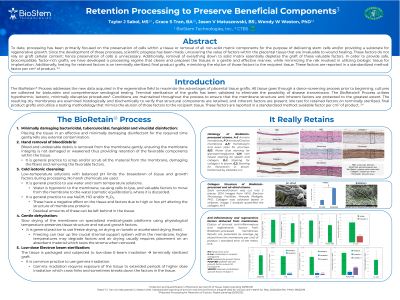Laboratory Research
(LR-045) Retention Processing to Preserve Beneficial Components
Friday, April 28, 2023
7:15 PM - 8:30 PM East Coast USA Time

Grace Tran, BA, CTBS – Lead Processing Technician, BioStem Technologies; Jason Matuszewski, BS – Chief Executive Officer, BioStem Technologies; Wendy Weston, PhD, CTBS – VP Research and Development, BioStem Technologies
Introduction: To date, processing has been primarily focused on the preservation of cells within a tissue or removal of all non-solid matrix components for the purpose of delivering stem cells and/or providing a substrate for regenerative growth. Since the development of these processes, scientific progress has been made, uncovering the value of factors within the placental tissue that are invaluable to wound healing. These factors do not rely on graft cellular content; hence preservation of cells is unnecessary. Additionally, removal of everything down to solid matrix essentially depletes the graft of these valuable factors. The reported process addresses the new data acquired in the regenerative field to maximize the advantages of placental tissue grafts.
Methods: All tissue went through a donor-screening process prior to beginning and cultures were collected for bioburden and comprehensive serological testing. Terminal sterilization of the grafts was validated to eliminate the possibility of disease transmission. The process utilizes hypothermic, isotonic, minimally disruptive procedures5. Conditions are maintained throughout the process to ensure that the membrane structure and inherent factors are protected to the greatest extent. The resulting dry membranes are examined histologically and biochemically to verify that structural components are retained, and inherent factors are present. We test for retained factors on terminally sterilized, final product grafts and utilize a testing methodology that mimics the elution of those factors to the recipient tissue.3,4
Results: Histology revealed intact structure by Hematoxylin and eosin stain, glycosaminoglycans by Alcian blue staining, elastin and collagen by Van Gieson staining, and abundant collagen I and fibronectin. SEM images of gently processed stroma showed retention of collagen structure as compared to and air-dried stroma. Stromal, anti-inflammatory and regenerative factors were eluted from the membranes.
Discussion: In order to provide safe, biocompatible, factor-rich grafts, we have developed a processing regime that cleans and prepares the tissues in a gentle and effective manner, while minimizing the risk involved in utilizing biologic tissue for implantation.
Methods: All tissue went through a donor-screening process prior to beginning and cultures were collected for bioburden and comprehensive serological testing. Terminal sterilization of the grafts was validated to eliminate the possibility of disease transmission. The process utilizes hypothermic, isotonic, minimally disruptive procedures5. Conditions are maintained throughout the process to ensure that the membrane structure and inherent factors are protected to the greatest extent. The resulting dry membranes are examined histologically and biochemically to verify that structural components are retained, and inherent factors are present. We test for retained factors on terminally sterilized, final product grafts and utilize a testing methodology that mimics the elution of those factors to the recipient tissue.3,4
Results: Histology revealed intact structure by Hematoxylin and eosin stain, glycosaminoglycans by Alcian blue staining, elastin and collagen by Van Gieson staining, and abundant collagen I and fibronectin. SEM images of gently processed stroma showed retention of collagen structure as compared to and air-dried stroma. Stromal, anti-inflammatory and regenerative factors were eluted from the membranes.
Discussion: In order to provide safe, biocompatible, factor-rich grafts, we have developed a processing regime that cleans and prepares the tissues in a gentle and effective manner, while minimizing the risk involved in utilizing biologic tissue for implantation.

.png)